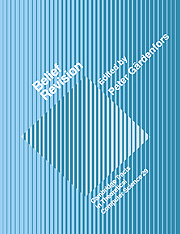Book contents
- Frontmatter
- Contents
- Belief revision: An introduction
- Reason maintenance and belief revision: Foundations versus coherence theories
- Syntax based approaches to belief revision
- A dyadic representation of belief
- On the logic of theory change: More maps between different kinds of contraction functions
- Belief change and possibility theory
- On the difference between updating a knowledge base and revising it
- Planning from first principles
- Autonomous belief revision and communication
- Conditionals and knowledge-base update
- Index
On the logic of theory change: More maps between different kinds of contraction functions
Published online by Cambridge University Press: 21 September 2009
- Frontmatter
- Contents
- Belief revision: An introduction
- Reason maintenance and belief revision: Foundations versus coherence theories
- Syntax based approaches to belief revision
- A dyadic representation of belief
- On the logic of theory change: More maps between different kinds of contraction functions
- Belief change and possibility theory
- On the difference between updating a knowledge base and revising it
- Planning from first principles
- Autonomous belief revision and communication
- Conditionals and knowledge-base update
- Index
Summary
INTRODUCTION
There are many ways to change a theory. The tasks of adding a sentence to a theory and of retracting a sentence from a theory are non-trivial because they are usually constrained by at least three requirements. The result of a revision or contraction of a theory should again be a theory, i.e., closed under logical consequence, it should be consistent whenever possible, and it should not change the original theory beyond necessity. In the course of the Alchourrón-Gärdenfors-Makinson research programme, at least three different methods for constructing contractions of theories have been proposed. Among these the “safe contraction functions” of Alchourrón and Makinson (1985, 1986) have played as it were the role of an outsider. Gärdenfors and Makinson (1988, p. 88) for instance state that ‘another, quite different, way of doing this [contracting and revising theories] was described by Alchourrón and Makinson (1985).’ (Italics mine.) The aim of the present paper is to show that this is a miscasting.
In any case, it seems that the intuitions behind safe contractions are fundamentally different from those behind its rivals, the partial meet contractions of Alchourrón, Gärdenfors and Makinson (1985) and the epistemic entrenchment contractions of Gärdenfors and Makinson (1988). Whereas the latter notions are tailored especially to handling theories (as opposed to sets of sentences which are not closed under a given consequence operation), safe contraction by its very idea focusses on minimal sets of premises sufficient to derive a certain sentence.
- Type
- Chapter
- Information
- Belief Revision , pp. 122 - 141Publisher: Cambridge University PressPrint publication year: 1992
- 16
- Cited by

